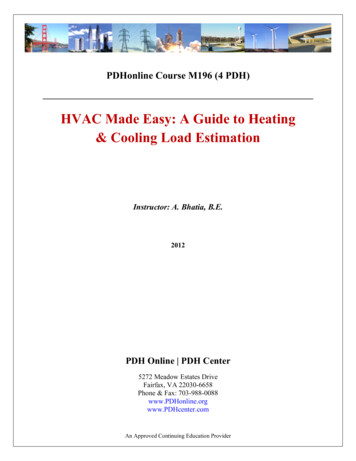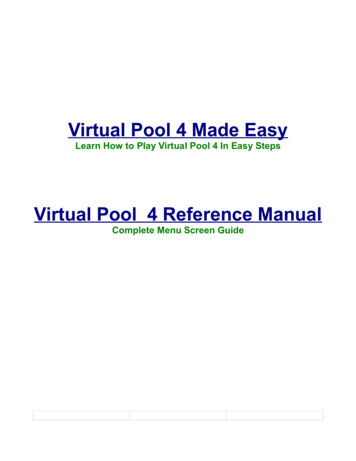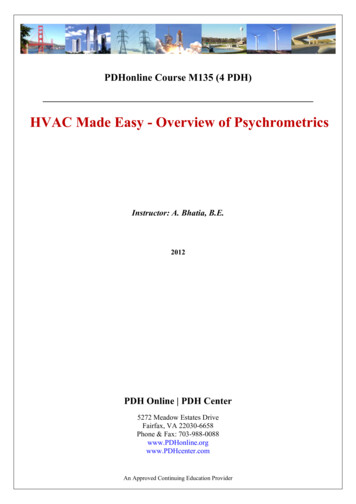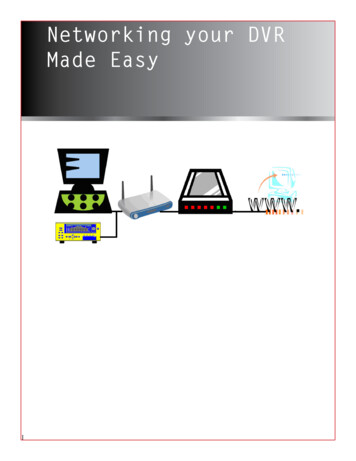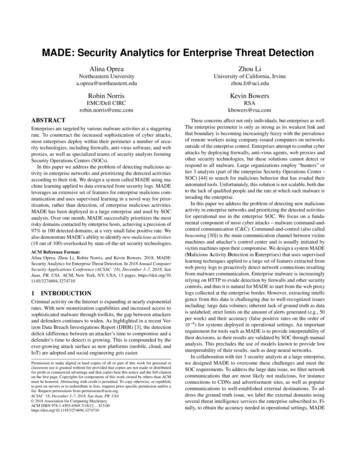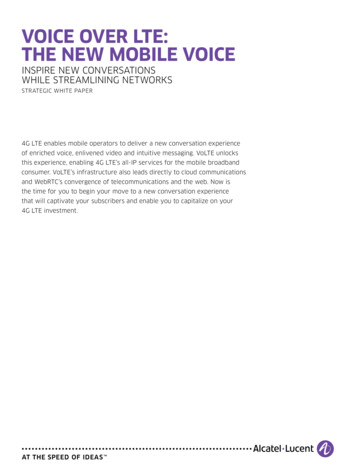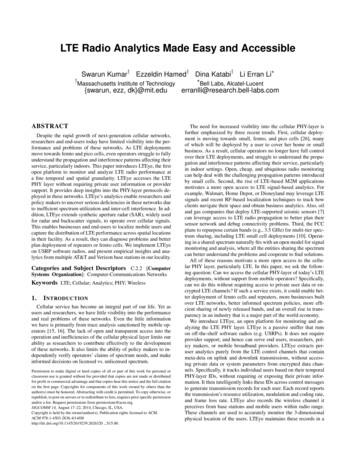
Transcription
LTE Radio Analytics Made Easy and Accessible†Swarun Kumar†Massachusetts Institute of Technology{swarun, ezz, dk}@mit.eduABSTRACTDespite the rapid growth of next-generation cellular networks,researchers and end-users today have limited visibility into the performance and problems of these networks. As LTE deploymentsmove towards femto and pico cells, even operators struggle to fullyunderstand the propagation and interference patterns affecting theirservice, particularly indoors. This paper introduces LTEye, the firstopen platform to monitor and analyze LTE radio performance ata fine temporal and spatial granularity. LTEye accesses the LTEPHY layer without requiring private user information or providersupport. It provides deep insights into the PHY-layer protocols deployed in these networks. LTEye’s analytics enable researchers andpolicy makers to uncover serious deficiencies in these networks dueto inefficient spectrum utilization and inter-cell interference. In addition, LTEye extends synthetic aperture radar (SAR), widely usedfor radar and backscatter signals, to operate over cellular signals.This enables businesses and end-users to localize mobile users andcapture the distribution of LTE performance across spatial locationsin their facility. As a result, they can diagnose problems and betterplan deployment of repeaters or femto cells. We implement LTEyeon USRP software radios, and present empirical insights and analytics from multiple AT&T and Verizon base stations in our locality.Categories and Subject Descriptors C.2.2 [ComputerSystems Organization]: Computer-Communications NetworksKeywords LTE; Cellular; Analytics; PHY; Wireless1.†Ezzeldin HamedI NTRODUCTIONCellular service has become an integral part of our life. Yet asusers and researchers, we have little visibility into the performanceand real problems of these networks. Even the little informationwe have is primarily from trace analysis sanctioned by mobile operators [15, 16]. The lack of open and transparent access into theoperation and inefficiencies of the cellular physical layer limits ourability as researchers to contribute effectively to the developmentof these networks. It also limits the ability of policy makers to independently verify operators’ claims of spectrum needs, and makeinformed decisions on licensed vs. unlicensed spectrum.Permission to make digital or hard copies of all or part of this work for personal orclassroom use is granted without fee provided that copies are not made or distributedfor profit or commercial advantage and that copies bear this notice and the full citationon the first page. Copyrights for components of this work owned by others than theauthor(s) must be honored. Abstracting with credit is permitted. To copy otherwise, orrepublish, to post on servers or to redistribute to lists, requires prior specific permissionand/or a fee. Request permissions from permissions@acm.org.SIGCOMM’14, August 17–22, 2014, Chicago, IL, USA.Copyright is held by the owner/author(s). Publication rights licensed to ACM.ACM 619239.2626320 . 15.00.†Dina Katabi?Li Erran Li?Bell Labs, Alcatel-Lucenterranlli@research.bell-labs.comThe need for increased visibility into the cellular PHY-layer isfurther emphasized by three recent trends. First, cellular deployment is moving towards small, femto, and pico cells [26], manyof which will be deployed by a user to cover her home or smallbusiness. As a result, cellular operators no longer have full controlover their LTE deployments, and struggle to understand the propagation and interference patterns affecting their service, particularlyin indoor settings. Open, cheap, and ubiquitous radio monitoringcan help deal with the challenging propagation patterns introducedby small cells. Second, the rise of LTE-based M2M applicationsmotivates a more open access to LTE signal-based analytics. Forexample, Walmart, Home Depot, or Disneyland may leverage LTEsignals and recent RF-based localization techniques to track howclients navigate their space and obtain business analytics. Also, oiland gas companies that deploy LTE-supported seismic sensors [7]can leverage access to LTE radio propagation to better plan theirsensor network and debug connectivity problems. Third, the FCCplans to repurpose certain bands (e.g., 3.5 GHz) for multi-tier spectrum sharing, including LTE small cell deployments [10]. Operating in a shared spectrum naturally fits with an open model for signalmonitoring and analysis, where all the entities sharing the spectrumcan better understand the problems and cooperate to find solutions.All of these reasons motivate a more open access to the cellular PHY layer, particularly LTE. In this paper, we ask the following question: Can we access the cellular PHY-layer of today’s LTEdeployments, without support from mobile operators? Specifically,can we do this without requiring access to private user data or encrypted LTE channels? If such a service exists, it could enable better deployment of femto cells and repeaters, more businesses builtover LTE networks, better informed spectrum policies, more efficient sharing of newly released bands, and an overall rise in transparency in an industry that is a major part of the world economy.We introduce LTEye, an open platform for monitoring and analyzing the LTE PHY layer. LTEye is a passive sniffer that runson off-the-shelf software radios (e.g. USRPs). It does not requireprovider support, and hence can serve end users, researchers, policy makers, or mobile broadband providers. LTEye extracts peruser analytics purely from the LTE control channels that containmeta-deta on uplink and downlink transmissions, without accessing private data or system parameters from encrypted data channels. Specifically, it tracks individual users based on their temporalPHY-layer IDs, without requiring or exposing their private information. It then intelligently links these IDs across control messagesto generate transmission records for each user. Each record reportsthe transmission’s resource utilization, modulation and coding rate,and frame loss rate. LTEye also records the wireless channel itperceives from base stations and mobile users within radio range.These channels are used to accurately monitor the 3-dimensionalphysical location of the users. LTEye maintains these records in a
database called LTEyeDB. It processes the records to generate twodimensions of fine-grained analytics: temporal analytics, to trackLTE performance over time, and spatial analytics, to characterizeLTE service across spatial locations.We implemented LTEye on USRP software radios [8]. We deployed LTEye in four locations in our campus to compare the temporal performance of two major LTE providers: AT&T and Verizon.Our results revealed several inefficiencies in these networks. First,both providers deploy a Frequency Division Duplexing scheme,which uses independent equally sized frequency bands for uplink and downlink traffic. However, LTEye reported that for bothproviders, the average utilization of downlink resources (25.2%- AT&T, 58.2% - Verizon) far exceeded that of uplink resources(0.6% - AT&T, 2.6% - Verizon). While it is expected that the downlink is higher in demand, our results reveal that the LTE uplink is aremarkable 20 to 40 times less utilized than the downlink. LTEye’sanalytics can therefore help policy makers encourage operators toadopt revised LTE standards that allow more prudent allocation ofresources to the uplink and downlink1 , without relying on data fromproviders themselves to make the case.Second, LTEye localized certain spots in our campus, whereVerizon cellphones suffer poor link quality and often switch to3G, despite reporting high signal power from the LTE base station. To investigate this, we moved our LTEye sniffers to thesespots and found that they experienced high inter-cell interference(about 27 dB) from as many as five different base stations. Tomake matters worse, many of these base stations used overlappingchannel estimation pilots, significantly impacting the decodabilityof these transmissions. These results help end-users identify poorplacement of femto cells that cause such interference. Further, theybenefit cellular providers themselves because they reveal interference problems that end-users face in indoors, hitherto inaccessibleto providers. Interestingly, some of these PHY-layer inefficienciesmay be unknown even to the operators as they are part of the PHYlayer implementations adopted by the base station vendors.2LTEye also benefits researchers by providing deep insights intothe PHY-layer protocols deployed by cellular providers. While theLTE standard spells out much of the PHY layer, the choice of rateadaptation algorithm is still left to individual operators. To gaininsights into this algorithm, we analyzed LTEyeDB records of anAT&T base station in our locality. We found that even for staticusers with completely coherent channels and stable SNRs, the modulation and coding scheme changes significantly even between adjacent transmissions. More interestingly, the average modulationand coding of frames sent to a user changes, based not only on herwireless channels, but also on the network state as a whole. Specifically, if the network is scarcely utilized, the base station transmitsto the user conservatively at low modulation on average, even ifthe wireless link is stable and supports much higher modulation.In contrast, as network utilization increases, under identical SNRs,the base station steadily increases its modulation to support moreaggressive data rates to the user. Such analytics on the performanceand design choices of today’s cellular operators help researchersdesign better LTE protocols.LTEye enables businesses and network administrators to continuously monitor the spatial locations of mobile users, and build ageographic heatmap of LTE coverage and performance within theirfacility. However, accurately localizing mobile users purely basedon their LTE signals is a challenging task. This is because past workon accurate indoor localization proposes two classes of solutions1E.g. Asymmetric Carrier Aggregation [19] in LTE Advanced(3GPP Release 10) allows downlink resources to exceed the uplink.2We confirmed this privately with some base station vendors.that are ill-suited to LTE networks: First, localization using antennaarrays [30, 18] requires large bulky arrays, owing to the relativelylow frequencies of LTE signals. Second, recent localization techniques using synthetic aperture radar (SAR) are less bulky, but arelimited to signals transmitted and received by the same node (e.g.radar [12] or RFID backscatter [29] systems) and therefore do notapply to LTE signals. LTEye provides the best of both these solutions by extending SAR localization techniques to operate overcommunication signals as opposed to backscatter or radar signals.It also introduces a novel technique to handle errors due to multipath by identifying the shortest (or most direct) path.Our evaluation of LTEye’s spatial analytics in large indoor environments reveals a median accuracy in 3D localization of mobile users of 61 cm in line-of-sight and 85 cm in non-line-of-sightsettings. Further, we visualize the LTE performance of the mobileusers across locations, helping building managers find optimal locations for relays or femtocells.Contributions: This paper contributes the following: The paper presents LTEye, the first open platform to monitor andanalyze per-user LTE PHY performance at fine temporal and spatial granularity. LTEye employs a new technique to identify and track individualusers at the LTE PHY layer in a robust manner, without helpfrom operators, and without requiring or exposing private userinformation. LTEye develops an innovative technique for accurate localization of users based on their LTE signals. This involves extendingsynthetic aperture radar (SAR) to operate over communicationsignals as opposed to backscatter and radar signals, and a noveltechnique for identifying the shortest and most direct path in thepresence of multipath. LTEye’s evaluation on AT&T and Verizon LTE deployments reveal deep insights on the inefficiencies, utilization patterns, anddifferences between these providers. LTEye also provides heatmaps to characterize LTE performance across indoor locations,without GPS support.2.R ELATED W ORK(a) LTE Sniffing Equipment: Devices such as Wavejudge,ThinkRF and IntelliJudge [25, 28] are wireless protocol sniffers tocapture RF signals. They are mainly tools for wireless developmentand interoperability testing that provide visibility into the interaction between the PHY and protocol layers. Unlike LTEye, thesedevices need inputs from the cellular provider and do not performlocalization or provide spatial analytics.(b) Open LTE Implementations: There have been efforts in developing open source implementations of LTE protocols, notably OpenAirInterface [9], and OSLD [13]. These initiatives enable runningLTE base stations on software radios; they do not extract spatial ortemporal analytics.(c) LTE Measurement Studies: Many recent LTE studies havebeen conducted using traces collected on participating smartphonesor from inside LTE networks. Findings from these studies include:(1) The available bandwidth of LTE networks is highly variable andTCP is not able to fully utilize the bandwidth [16]; (2) LTE is significantly less power efficient than Wi-Fi [15]; (3) LTE latency ismore consistent (less variable) than Wi-Fi [27]. Such studies focuson the higher layers of the stack, e.g., TCP throughput, transfer delay, and power usage. In contrast, LTEye focuses on the LTE radiolayer; it provides fine-grained temporal and spatial information anddoes not require traces from the provider.
RX SamplesSubframe (1ms)RB 4912 Subcarriers 80 KHzResourceBlockControlMessagesRB 27DataRB 22ResourceElement7 Symbols (0.5ms)Figure 1: The Resource Grid is divi
user analytics purely from the LTE control channels that contain meta-deta on uplink and downlink transmissions, without access-ing private data or system parameters from encrypted data chan-nels. Specifically, it tracks individual users based on their temporal PHY-layer IDs, without requiring or exposing their private infor-mation. It then intelligently links these IDs across control messages

